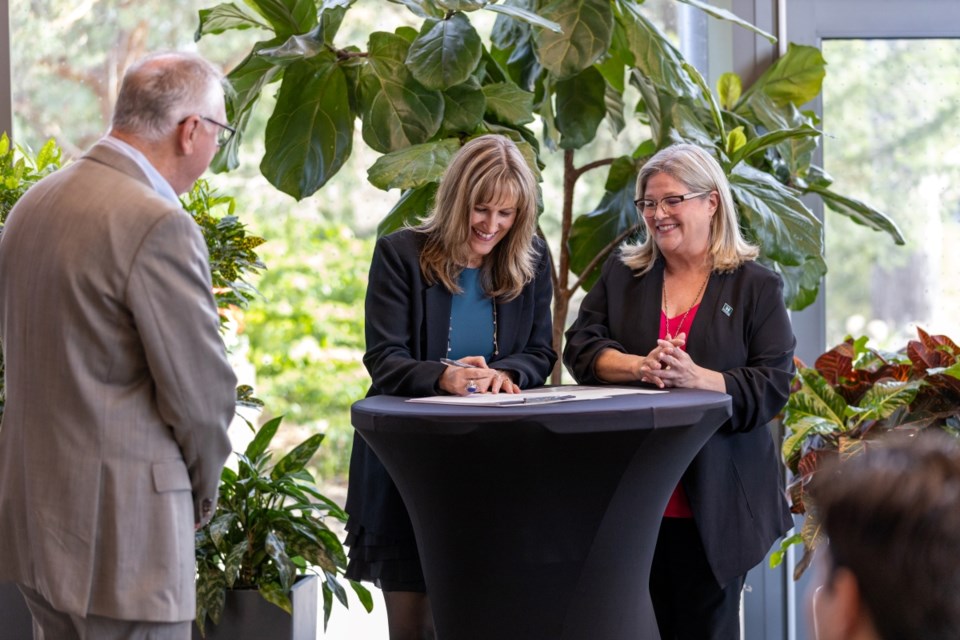Hamilton and Burlington mayors are working in collaboration to make a climate change difference and they shared their experiences at a climate forum.
The Bay Area Climate Change Council (BACCC) is a joint initiative between the cities of Burlington, Hamilton and Mohawk College to work collaboratively on a regional climate action plan.
BACCC recently made a presentation to Burlington council to reaffirm the city’s support and financial contribution of $56,000 per year.
On Tuesday (May 7) BACCC hosted its annual Climate Forum for the public at Royal Botanical Gardens, featuring Burlington Mayor Meed Ward and Hamilton Mayor Andrea Horwath to speak about each city’s commitment to climate action, and keynote speaker Jennifer Keesmaat, former chief city planner for Toronto.
Jesse Elders, manager of BACCC, stated, “BACC goal is to achieve net-zero carbon emissions by 2050. This goal aligns with the climate commitments made by both the City of Hamilton and the City of Burlington. BACC focuses on emission reductions in the big three sources of emissions in the Bay area – industry, buildings and transportation.”
A brief panel discussion with both Burlington and Hamilton mayors gave them the opportunity to list some of the achievements and plans their cities have taken to reach those emission targets. Improvements in transit; stormwater management; deep energy retrofits on city buildings; interest free loans for the installations of heat pumps; climate action plans; dedicated environmental staff and departments; and other climate actions were all mentioned.
Meed Ward highlighted the new Skyway Arena and Community Centre, under construction, that will be net carbon neutral, and the 40 per cent increase in transit ridership due, in part, to the free fares for seniors and children under 12, and for youth after 6 p.m. and on weekends.
In a nod to the theme of the event, collaboration, Meed Ward said, “Climate change action is also good business. People are saying ‘it’s not business or the environment - it’s business and the environment doing it together’.”
Horwath assured the crowd that the LRT would be built in Hamilton and that one of the access routes to the upper level of the city had to be repaired due to the collapse of some of the escarpment rock face, most likely caused by climate change.
“The impact of heat change is significant, especially on the most vulnerable in the community,” noted Horwath.
The mayor went on to explain that the Intact Centre on Climate Adaptation identified Hamilton as one of the top 10 Canadian municipalities projected to have the warmest days of maximum temperatures (over 30 degrees) and the longest heat waves in the future.
That led both mayors to speak of their forestry departments’ targets for tree canopy which prompted an informal, lighthearted, challenge to top forestry coverages to 35-40-50 per cent of ground cover.
Jennifer Keesmaat, of the urban planning Keesmaat Group, and co-founder of Markee Developments, was the keynote speaker at the event. Keesmaat brought her practical presentation with plenty of positive examples of what smart urban planning and a collaborative approach can do to accomplish sustainable goals and complete community objectives.
“The future is collaborative,” said Keesmaat. “It means that unlike most conversations about climate this is one that has kind of an upbeat tone. Usually we talk about how hard it is. We talk about how much we need to get done. Instead, we need to believe that there are things that we can do in our policy making, through our political leadership, and in our everyday lives that can result in change. All of us have a sphere of influence and within that sphere of influence we can impact change.”
Keesmaat continued, “We know that timeless principles of urbanism, that define a sustainable future that shares prosperity, are actually not new. We know how to build sustainable places. I want to talk about how we use land because it doesn’t matter how many electric bikes and electric cars we have if we continue to plan our land the same way we’re planning it today. Planning for social connectedness and belonging will mitigate disaster for vulnerable populations. With all of our AI, all of our prosperity, and all of our ingenuity we see more people in distress than ever in our cities. And thinking and planning about vulnerable populations as we move forward in creating a more sustainable future is a fundamental part of the crisis we need to respond to.”
Keesmaat will be bringing a slightly different presentation (on housing) to the Mayor’s Speaker Series event at the Burlington Performing Arts Centre on Monday, May 27 at 7 p.m.



